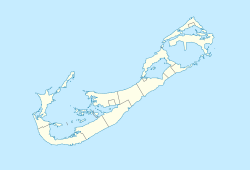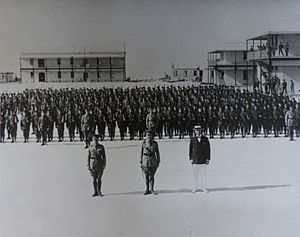Prospect Camp, Bermuda facts for kids
Quick facts for kids Prospect Camp |
|
|---|---|
| Devonshire Parish, Bermuda | |
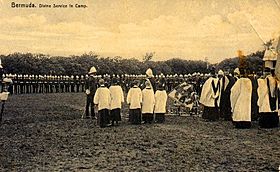
Presentation of colours at Prospect Camp recreation ground (now the Bermuda National Stadium)
|
|
|
Location in Bermuda
|
|
| Coordinates | 32°17′58″N 64°45′55″W / 32.2994949°N 64.7653454°W |
| Type | Barracks |
| Site information | |
| Owner | Ministry of Defence |
| Operator | |
| Site history | |
| Built | circa 1850 |
| In use | 1850s–1957 |
| Garrison information | |
| Garrison | Bermuda Garrison |
Prospect Camp, also known as Prospect Garrison, was the main army base in Bermuda. It was home to the infantry soldiers of the Bermuda Garrison. This was the military force stationed on the island.
The camp also included Fort Prospect, Fort Langton, and Fort Hamilton. These were forts with large guns to protect the coast. Prospect Camp was also a base for mobile artillery, which are cannons that can be moved. These were operated by the Royal Artillery.
Some parts of the camp were sold off in the early 1900s. This happened as the number of soldiers in Bermuda was reduced. The main part of the camp, including the barracks (soldiers' living quarters), was given to the local government in 1957. This was when the military garrison left Bermuda.
Contents
History of Prospect Camp
Early Military Presence in Bermuda
The British military presence in Bermuda grew from the 1790s. This happened as the Royal Navy (Britain's navy) built up its facilities there. After the United States became independent, Britain lost its naval bases on the American mainland. Bermuda then became very important to the Royal Navy. It was located about 640 miles off the coast of North Carolina.
The navy started buying land around Bermuda. They wanted to build a large dockyard for their warships. At first, the main naval base was in St. George's Harbour. The army also built a large garrison (military base) near St. George's Town. Many forts and batteries were built across Bermuda. Most of the army's soldiers were based in St. George's Garrison.
Building Prospect Camp
By 1812, the navy was building a new dockyard. This was the Royal Navy Dockyard on Ireland Island in the west of Bermuda. The new capital of Bermuda, Hamilton, was also growing in the central part of the island. It became the capital in 1815.
Because of these changes, the army needed to move many of its soldiers closer to Hamilton and the dockyard. So, in the mid-1800s, the army bought land in Devonshire. They started building a large camp there. This camp was designed to house most of the infantry soldiers in Bermuda.
This new base was called Prospect Camp. It became the headquarters for Bermuda's military garrison. It had barracks, parade grounds, and training areas. It also included Prospect Fort, which had big guns to protect the coast. These guns worked with those at Fort Hamilton and Fort Langton to guard the shores around Hamilton.
Prospect Camp had large areas for training soldiers. However, it was surrounded by roads and homes. This meant it didn't have a safe place for a rifle range. So, another camp called Warwick Camp was added. This camp was mainly used for rifle practice. Soldiers from Prospect Camp and the Royal Marines from the dockyard would go there to train.
Other smaller sites were also used by the army. These included Watford Island and Boaz Island. These islands were part of the dockyard's land. They once housed prisoners who helped build the dockyard. After the prisoners left in the 1860s, these islands were given to the army. They could hold many soldiers. Bermuda was divided into three military areas. These were centered on Clarence Barracks, Prospect Camp, and St. George's Garrison. Prospect Camp was the main headquarters for the entire military command.
Life and Training at the Camp
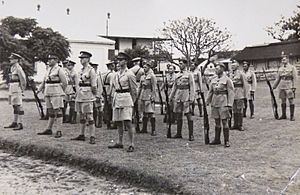
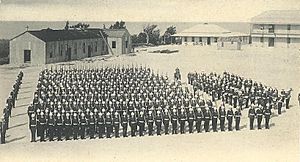

For much of the 1800s, a full battalion of infantry soldiers lived in Bermuda. There were also artillery, engineer, and other support units. By the 1860s, Britain planned to reduce the number of soldiers in Bermuda. This was due to money issues and a plan to keep more soldiers in Britain.
However, Bermuda remained an important naval base. So, the regular soldiers stayed at full strength for many years. This continued until the government of Bermuda created its own part-time military units. These were the Bermuda Militia Artillery and the Bermuda Volunteer Rifle Corps. These local units took on some of the duties of the main garrison.
After this, the number of regular soldiers in Bermuda slowly decreased. Between World War I and World War II, the regular Royal Artillery and Royal Engineers left completely. Their duties were taken over by the local Bermuda Militia Artillery and the Bermuda Volunteer Engineers. Although some regular infantry soldiers remained, Bermuda no longer had a full garrison. Only a small company of soldiers was stationed at Prospect Camp.
During the Second World War, Prospect Camp was very busy. It housed the headquarters and the regular infantry. It was also used to train local part-time soldiers. These soldiers were called up for full-time duty during the war. For example, the first group of soldiers from the Bermuda Volunteer Rifle Corps trained at Prospect Camp. They then went to England to join the Lincolnshire Regiment.
In 1943, Prospect Camp housed a special Training Battalion. This group was made up of volunteers from different local units. They trained for deployment overseas. This battalion later split into two groups. One group joined the Lincolnshire Regiment in Britain. The other group helped form the new Caribbean Regiment.
Closing of the Camp
In 1951, it was announced that the Royal Navy's dockyard would close. This process took several years, ending in the late 1950s. Without the large dockyard, and with the USA having its own naval and air bases in Bermuda, the British military garrison was no longer needed.
The last plan for Bermuda's defense was made in 1953. After this, the local part-time military units no longer had a role assigned by the British War Office. The last group of regular soldiers, from the Duke of Cornwall's Light Infantry, left in 1957. After they left, Prospect Camp and most other military properties in Bermuda were given to the local government. This transfer cost £750,000.
What is Prospect Camp Now?
After the military left, Prospect Camp was divided up. Different government departments and private owners took over parts of the land. The Bermuda Police Service became a main user. They set up their headquarters, barracks, and other units there.
The Department of Education also used parts of the former camp. Prospect Secondary School was once in the old barracks buildings. The campus for Bermuda College was also first located there. In the 1990s, some of the old barracks were taken down. The new Cedarbridge Academy school was built in their place. The Bermuda National Stadium also stands on part of the former military camp grounds.


